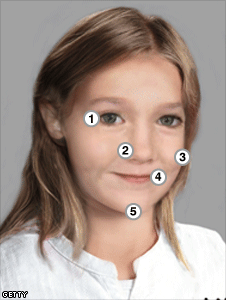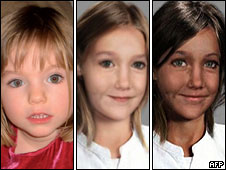 |
1: Eyes largely stay
the same, though
pupils may shrink
2: Nose will grow
outwards and become
more defined
3: Bone and teeth
growth will change
face shape
4: Mouth will be
larger
5: Chin will have
grown out and
downwards
Source: Auriole Prince
|
|
|
|
Madeleine McCann's face is probably one
of the most recognisable in the world, but it is the face of a
four-year-old Madeleine and that is the problem.
Two-and-a-half years after she vanished
from a Portuguese holiday flat, police have issued age-progressed images
of how she may look today.
They are aimed at "pricking the
conscience" of people who know what happened to her. But how are the
pictures created?
Police use specialist age-progression
artists to generate such images. They use different techniques,
including drawing, but usually produce computer-generated images.
There is no specific age-progression
software, but the artist uses existing computer packages to manipulate
features.
As a child grows their eyes will largely
stay the same but everything below the eyes grows outwards and
downwards, says age-progression artist Auriole Prince.
"Trying to show how this growth changes
a face is like piecing together a puzzle," she says. "There's an upside
down triangle between the eyes, nose and the mouth. The relationship
between these features is the most important in keeping the likeness."
Ideally an artist will have an original
portrait-style photograph of the person who is going to be
age-progressed, along with other photos showing them at different angles
and with varying expressions.
They also use
photographs of other family members. As a rough guide, 70 to 75% of
an age-progressed face
can be extrapolated from pictures of the subject's parents taken at the
same age as the child, says Ms Prince. Pictures of siblings will also be
helpful.
Along with artistic skills,
age-progression artists also need to have a good knowledge of the
 |
Madeleine, left, and two aged-progressed photos of
her
|
anatomy of the face. This is because
bone growth and dental changes can have a real impact on what a person
looks like, especially at certain ages.
"From age four to six, like Madeleine,
a person will go through a lot of changes," says Ms Prince, who works
with police and also worked for the National Missing Persons Helpline
for eight years. She trained in the US with the FBI and the National
Center for Missing and Exploited Children.
"But some of the biggest alterations
take place from age seven to eight. This is because a person's
underlying bone structure really grows, milk teeth fall out and the new
teeth emerge."
Contrary to popular belief, a child's
eyes do not remain the same size from birth. But their growth is minimal
compared with the lower face. However, an age progression artists will
sometimes shrink the pupils - revealing more whites of the eyes - to
imply aging, says Ms Prince.
 |
WHO, WHAT,
WHY?
A regular part
of the BBC News Magazine, Who, What, Why? aims to answer
some of the questions behind the headlines
|
In cases of vanished children, the
child must usually have been missing for at least two years to warrant
an age progression image, says Ms Prince. The child must also tend to be
at least two at the time they went missing.
In terms of success in reproducing a
likeness, Ms Prince stresses age progression is more about renewing
publicity and moving on the public's perception of a person, than
creating a facsimile of what a person may look like. They are often used
in long-running missing persons cases like Ben Needham, who disappeared
on the Greek island of Kos in 1991.
"In this case the public will still be
looking for the four-year-old Madeleine and the police want them to look
for six-year-old girl," says Ms Prince.
|





